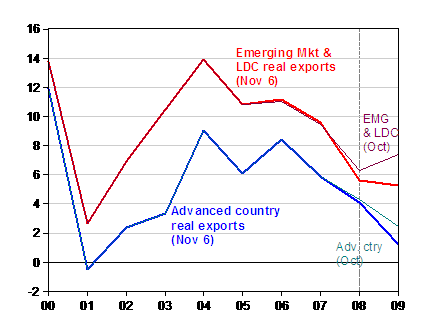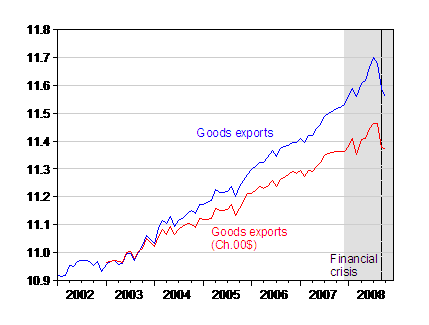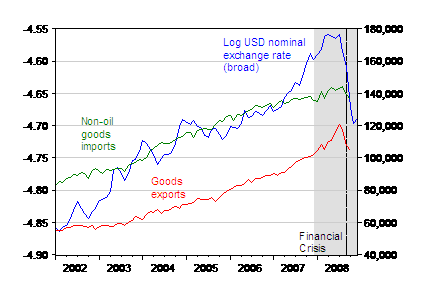From “Trade-Finance Pinch Hurts the Healthy,” WSJ, 12/22/08:
The global financial crisis is drying up the financing that firms depend on for trade. That’s making the global recession nastier and deeper than it otherwise would be.
As with all kinds of credit these days, financial institutions are making less trade finance available and charging more for it. But the squeeze in trade stands out because it pinches otherwise healthy companies that should be driving a recovery in global commerce. Already, the World Bank predicts trade will contract next year for the first time since 1982.
The Deteriorating Trade Outlook
Here’s the IMF’s recent forecasts for exports — from October and then November — for world trade, disaggregated into advanced and developing country groupings.

Figure 1: Real goods and services exports by country group. Source: IMF, World Economic Outlook Oct. 2008; Nov. 6 WEO update.
These developments in trade financing suggest that the recent drop-off in US exports and imports might be due only in part to macroeconomic factors. In particular, I suspect that some of the precipitous decline in US non-oil imports is driven by difficulty in obtaining financing. Similarly, for US exports.

Figure 2: Log nominal goods imports ex oil (blue), and log real goods imports ex oil (red), in Ch.2000$. Gray shaded area denotes NBER defined trough and thereafter. Source: BEA/Census, October trade release, and NBER.

Figure 3: Log nominal goods exports (blue), and log real goods exports (red), in Ch.2000$. Gray shaded area denotes NBER defined trough and thereafter. Source: BEA/Census, October trade release, and NBER.
The article continues:
Despite better growth prospects in developing countries, many lenders are pulling back drastically from these regions. The institutions are cutting exposure to economies traditionally perceived as more risky in order to patch up holes in their balance sheets. Other big players in trade finance, such as Wachovia, have disappeared.
“For emerging markets, the deleveraging process is extensive, and dollar sources have dried up,” says Hung Tran, an economist at the Institute of International Finance, a Washington association of international financial firms.
Dating back to ancient commercial hubs such as ninth-century Baghdad, trade finance is the collection of hard-currency credit lines, insurance policies and guarantees that allows firms in different countries to do business with each other. It’s the oil that lubricates $14 trillion of global trade.
“The trade-finance business globally is under significant stress,” says John Ahearn, the global head of trade finance at Citigroup, one of the world’s biggest trade-finance sources. Some repricing is expected as the globe readjusts from a period where credit flowed too freely. “We are coming out of an incredibly benign credit environment when trust levels were too high,” says Stuart Nivison, head of trade and supply chain at HSBC Holdings.
Even big lenders such as Citigroup and HSBC that have expanded international credit lines to some markets recently are hitting obstacles. A big part of these banks’ business is setting up trade lines that are offloaded to smaller banks in a secondary market. These days, however, the smaller banks aren’t buying.
Consider what’s happening in Brazil, an emerging export power that sells the world everything from soy and beef to iron ore and jets. Brazilian companies need dollar-denominated credit to finance the sales. The cost of these credit lines — the bread and butter of trade finance — has soared, doubling in many cases. The phenomenon hits smaller firms the hardest: Some no longer qualify for the lines and others are squeezed out of shrinking market by credit-hungry giants like state oil company Petroleo Brasileiro.
…
At times, credit is available, but the higher cost of it exceeds the profit margins, so the deals collapse. That’s especially the case in commodities transactions.
By the way, the spike up in the value of the dollar (represented in the downward movement in the USD exchange rate), while often mentioned in journalistic accounts, is unlikely to have had a big impact in the September and October figures, given the lags usually estimated in trade flow equations (for a discussion of lag lengths, see this paper [pdf]).

Figure 4: Log USD nominal exchange rate, broad basket (blue), goods exports, millions USD (red), and non-oil goods imports (blue), both seasonally adjusted. December USD figure is for statistics through Dec. 26. Gray shaded area denotes NBER defined trough and thereafter. Source: BEA/Census, October release, Federal Reserve, and NBER.
The observed co-movement is ascribable to the common factor of flight to safety and reduction in trade credits in the wake of the financial crisis (see some stunning pictures in Brad Setser’s recent post).
China
Other coverage is in Globe and Mail, Journal of Commerce, Reuters, Bloomberg. Many of the articles focus on China, and we now have some feeling for the combined macro/finance impact: “According to Chinese customs figures, Chinese exports declined 2.2% and imports fell 17.9% in November, compared with a year earlier.” (Volz in FEER.) This suggests to me that the more rapidly the supply of export credit can be restored (at least partially), the less significant the downturn in Chinese exports, and hence in the Chinese economy.
From Reuters:
Stunningly bad trade figures from China underlined the problem. China had been expected to show double digit growth in trade last month as compared to November 2007, but the data showed exports falling 2.2 percent from a year ago and imports down 17.9 percent.
“Global demand for Chinese products is vanishing,” said Gene Ma, an economist at China Economic Monitor, a Beijing consultancy. “Secondly, the credit freeze in importing countries has made it hard for Chinese exporters to sell abroad. I heard some Chinese exporters had to cancel shipments as they were worried about getting paid by their buyers.”
Chinese banks have been very nervous about accepting letters of credit from abroad, making it tougher for imports to China to get the needed financing. China and the U.S. pledged $20 billion to fund trade with developing countries last week, but that is a tiny balm for a huge market.
Some Disparate Observations
In some previous posts, I observed that globalization was a function of trade — and other transaction — costs [1], [2], [3]. That observation was focused on transportation costs, but it’s clear (in retrospect) that one of the drivers of globalization was decreasing financing costs. With financing costlier for the foreseeable future, secular growth in trade flows may be even more muted than one would expect from the slowdown in global GDP.
There is a good news/bad news aspect to this conclusion. The bad news is that decreased international trade means a reduction (relative to counterfactual) in the gains from exploiting comparative advantage. This will show up in further reduced GDP.
The good news, such as it is, is that reduced import penetration in the developed economies will mitigate protectionist tendencies. In addition, higher transactions costs (due to higher financing costs) will likely act to reduce the marginal propensity to import, thereby boosting the Keynesian multiplier (as described by me, and Dani Rodrik) in a way that will not induce retaliation. Of course, the net effect is still likely to be toward greater protectionism.
Technorati Tags: imports, exports, trade credit,
credit crunch, and protectionism.
How the propensity to import, and the Keynesian multiplier, respond to a stimulus will depend on the reactions of U.S. residents. For example, will the stimulus temporarily relieve ‘protectionist’ pressures by ameliorating hard economic times, thereby allowing foreign central banks to increase dollar purchases?
I have a problem talking about attempts to halt currency interventions as ‘protectionist.’ Maybe we need new terminology for artificially bloated trade caused by such policies. It is causing some dangerous global imbalances that need to be addressed. We can’t simply ignore them in the short term and focus only on ‘stimulus’ until U.S. borrowing becomes clearly unsustainable. I doubt if the end of that episode would come very gradually, with smooth adjustments. Instead, I think it would come rather suddenly, much like the LDC debt crisis of the ’80’s and the current subprime crisis, precipitated by a rise in interest rates.
The historical responses of the marginal propensity to import to increases in deficits may not be very good guides in the present circumstances. We seem to have moved rather suddenly out of a world where a full employment resource allocation model is appropriate and the response of the federal reserve matters and into a world where output is solely demand determined and conventional monetary policy is ineffective.
Menzie,
I appreciate that you’re attempting to keep readers up to speed on the financial and economic crisis. In reality, though, all one has to do is keep track of global and domestic freight movements beginning with the Baltic Index. The forward outlook through 2011 and according to some projections – 2012 – is negative, bordering on disastrous in terms of anticipating a near term recovery.
Meanwhile, the negative impacts of U.S. and WTO trade policies on the U.S. are matters that probably will not be addressed seriously until the recovery has reached some level of maturity. Regardless, the issues of current account and trade deficits must be addressed as the U.S. is not on a sustainable economic course. The growing loss of value-added GDP output is obvious to economists and others except for those who foolishly pretend that the loss does not exist. While the typical blame game may again be placed at the feet of individual and business consumers, the matter of production origin is the issue. And production origin shall remain the overriding issue. The phony excuses that ignore this core problem and pretend that U.S. consumers buy too many imported goods (and services) will not be successful once the subject is treated with the level of seriousness that it deserves in the Congress or the White House.
U.S. trade policy will be changed at some point if there is any intention to reverse the unsustainable economic path that the nation’s government has undertaken.
The decline in trade is an interesting one, but something that is seriously distorted by the present very rapid deflation, most notably in commodities prices.
Certainly physical quantities of trade have declined, but less so than there value. Paradoxically the present deflation creates the conditions for a growth of world trade, once the present write downs are complete and a the new lower price regime consolidated.
The baltic index shows this well. Its collapse certainly describes the decline in world trade from the late summer on, but not only that. It also illustrates the collapse in oil prices, the cost of trade, and the increase in the world’s merchant fleet, the capacity to trade.
Importantly creating conditions for a revival of world trade over the next months/years, as the cost of transportation has just collapsed.
The price of imports is falling by the most ever, and as a result so have manufacturing inputs, leading to a fall in manufacturing costs, a recovery of profit margins, and in the context of this discussion, restoring incomes and reflating the economy, while reducing the drain on domestic demand due to purchases of imports.
Thanks Menzie for a great overview of a developing situation. I was going to mention the Baltic Dry index but movieguy beat me to it.
I agree with your retrospective observation that inexpensive financing was a key driver in expanding global trade. It is ironic that not so long ago, some pundits were predicting a reduction in trade due to higher fuel costs.
I suspect that tightening credit for trade is an important factor behind crude oil price declines, and predictions in some circles of sub-US$20/barrel oil.
In the last sentence, shouldn’t “Of course, the net effect is still likely to be toward greater protectionism.” read “…toward greater autarchy.” ?
don: I agree that the it will be hard to guess what the marginal propensity to import will be, given our current unusual circumstances.
MovieGuy: Yes, I agree the Baltic Dry Index is dropping precipitously, and can be viewed as an alternative summary measure. The WEO forecasts embody expectations regarding the relatively long horizon.
None of these indicators, however, gets at the issue of decomposing the drop in trade flows due to decreased demand, and how much is due to tighter credit for financing trade specifically — which was what I was focusing on.
bill_j: I don’t deny that the decline in tradables prices is part of the adjustment process — but it’s an open question whether the prices are moving to equilibrium levels, or levels in part determined by a financing constraint.
GNP: Both are possible. I think protectionism rises during economic downturns. Lower trade-to-GDP ratios also seems plausible, though.
Menzie-
It would have been nice if you had labeled Fig. 1 as the ?Annual Percentage Change in Export Volume? ? Unfortunately, the IMF World Economic Outlook did not define what ?Export Volume? represents in their statistical tables? However, the IMF usage is most typically, that Export Volume = (Export Value / GDP Value) as a percentage.
As you correctly observed, the credit crunch and deleveraging has wiped out much of the liquidity used to support letters of credit and insurance involved in international trade. This was a direct result of the credit losses accrued in mortgage financing and its spin-offs in CDOs, SIVs, and CDSs. I would caution all your readers that the next wave of credit losses is soon to appear in speculative (high yield) bonds. In both 1991 and 2002, the global default rate on these instruments exceeded 10%., and their spreads reached approximately 10%. Currently, global defaults are at 3% but spreads are at 13%, (the market has already factored-in a default rate exceeding 10%). As these bonds default in 2009 and 2010, massive pressure on counterparty viability will occur in Credit Default Swaps similar to what occurred in last summer relative to mortgage securities. These losses will reduce liquidity again, and make trade financing even more expensive than it already is. See this Henry Tricks article from The Economist .
Yikes!
I goofed up the hyperlink to Henry Tricks:
See this Henry Tricks article for The Economist .
Also… Thanks Menzie for all your hard work in maintaining this blog with James. I find it constantly fascinating. Happy New Year.
MarkS: In conventional international trade usage, volume denotes a quantity measure (specifically value divided by price deflator). Here is some documentation.
Thanks for the link (now fixed) and support.